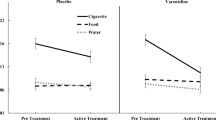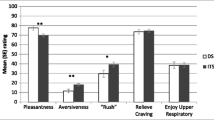Abstract
Rationale
It is widely believed that nicotine withdrawal symptoms appear within a few hours of stopping smoking, but few data exist documenting their emergence in naturalistic settings. In several countries, nicotine replacement products are licensed for relief of withdrawal symptoms during temporary abstinence, but again, there are no data supporting this from naturalistic settings.
Objectives
To examine the emergence of cigarette craving and withdrawal symptoms during temporary abstinence in a naturalistic setting while using either nicotine or placebo gum.
Methods
Double-blind, randomised, placebo-controlled study in which 132 dependent smokers abstained for 6 h with the assistance of either nicotine (2 mg, n = 42 or 4 mg, n = 24) or placebo (n = 66) gum while travelling on a non-smoking train. Outcome measures were ratings of craving and mood withdrawal symptoms prior to treatment and at regular intervals during abstinence.
Results
In a multivariate analysis of all symptoms, there was no interaction between treatment and time [F(21,110) = 1.28, p = 0.20, \( \eta_{\mathrm{p}}^2 \) = 0.20] nor an effect of treatment [F(7,124) = 0.45, p = 0.87, \( \eta_{\mathrm{p}}^2 \) = 0.03]. There was an effect of time [F(21,110) = 11.59, p < 0.001, \( \eta_{\mathrm{p}}^2 \) = 0.69) and univariate analyses revealed that the majority of symptoms increased linearly throughout the period of abstinence with detectable onsets typically between the first 60 and 180 min of abstinence.
Conclusions
Smokers who temporarily abstain in naturalistic settings experience craving and withdrawal symptoms that emerge linearly over the first 6 h of abstinence. Changes in craving and several mood withdrawal symptoms can be detected within the first 3 h. Nicotine gum may not have an acute effect on the development of these symptoms.



Similar content being viewed by others
References
American Psychiatric Association (1994) Diagnostic and statistical manual of mental disorders, 4th edn. American Psychiatric Association, Washington
Baker TB, Piper ME, McCarthy DE, Majeskie MR, Fiore MC (2004) Addiction motivation reformulated: an affective processing model of negative reinforcement. Psychol Rev 111(1):33–51. doi:10.1037/0033-295x.111.1.33
Baker TB, Breslau N, Covey L, Shiffman S (2012) DSM criteria for tobacco use disorder and tobacco withdrawal: a critique and proposed revisions for DSM-5*. Addiction 107(2):263–275. doi:10.1111/j.1360-0443.2011.03657.x
Beard E, West R (2012) Use of nicotine replacement therapy for smoking reduction and temporary abstinence: an update of Beard et al. (2011). Addiction 107(6):1186–1187. doi:10.1111/j.1360-0443.2012.03839.x
Beard E, Aveyard P, McNeill A, Michie S, Fidler JA, Brown J, West R (2012) Mediation analysis of the association between use of NRT for smoking reduction and attempts to stop smoking. Psychol Health 27(9):1118–1133. doi:10.1080/08870446.2012.685739
Beard E, Aveyard P, Michie S, McNeill A, West R (2013a) Does use of nicotine replacement therapy while continuing to smoke undermine cessation?: a systematic review. J Smok Cessat. doi:10.1017/jsc.2012.21
Beard E, Michie S, Fidler J, West R (2013b) Use of nicotine replacement therapy in situations involving temporary abstinence from smoking: a national survey of English smokers. Addict Behav 38: 1876–1879. doi: 10.1016/j.addbeh.2012.09.013
Bedi G, Preston KL, Epstein DH, Heishman SJ, Marrone GF, Shaham Y, de Wit H (2011) Incubation of cue-induced cigarette craving during abstinence in human smokers. Biol Psychiatry 69(7):708–711. doi:10.1016/j.biopsych.2010.07.014
Brose LS, West R, McDermott MS, Fidler JA, Croghan E, McEwen A (2011) What makes for an effective stop-smoking service? Thorax 66(10):924–926. doi:10.1136/thoraxjnl-2011-200251
Edwards G, Gross MM, Keller M, Moser J (1976) Alcohol-related problems in the disability perspective. A summary of the consensus of the WHO group of investigators on criteria for identifying and classifying disabilities related to alcohol consumption. J Stud Alcohol 37(9):1360–1382
Fidler JA, Shahab L, West R (2010) Strength of urges to smoke as a measure of severity of cigarette dependence: comparison with the Fagerstrom Test for Nicotine Dependence and its components. Addiction 106:631–638. doi:10.1111/j.1360-0443.2010.03226.x
Freeman TP, Morgan CJ, Beesley T, Curran HV (2012) Drug cue induced overshadowing: selective disruption of natural reward processing by cigarette cues amongst abstinent but not satiated smokers. Psychol Med 42(1):161–171. doi:10.1017/s0033291711001139
Gross J, Lee J, Stitzer ML (1997) Nicotine-containing versus de-nicotinized cigarettes: effects on craving and withdrawal. Pharmacol Biochem Behav 57(1–2):159–165
Harakeh Z, Engels RCME, Van Baaren RB, Scholte RHJ (2007) Imitation of cigarette smoking: an experimental study on smoking in a naturalistic setting. Drug Alcohol Depend 86(2–3):199–206. doi:10.1016/j.drugalcdep.2006.06.006
Heatherton TF, Kozlowski LT, Frecker RC, Rickert W, Robinson J (1989) Measuring the heaviness of smoking—using self-reported time to the 1st cigarette of the day and number of cigarettes smoked per day. Br J Addict 84(7):791–800
Hendricks P, Ditre J, Drobes D, Brandon T (2006) The early time course of smoking withdrawal effects. Psychopharmacology 187(3):385–396. doi:10.1007/s00213-006-0429-9
Hughes JR (2007a) Effects of abstinence from tobacco: valid symptoms and time course. Nicotine Tob Res 9(3):315–327. doi:10.1080/14622200701188919
Hughes JR (2007b) Measurement of the effects of abstinence from tobacco: a qualitative review. Psychol Addict Behav 21(2):127–137. doi:10.1037/0893-164x.21.2.127
Hughes JR, Higgins ST, Hatsukami DK (1990) Effects of abstinence from tobacco: a critical review. In: Kozlowski LT, Annis HM, Cappell HD, Glaser FB, Goodstat MS, Israel Y, Kalant H, Seelera EM, Vingilis ER (eds) Research advances in alcohol and drug problems. Plenum, New York, pp 317–398
Hughes JR, Gust SW, Skoog K, Keenan RM, Fenwick JW (1991) Symptoms of tobacco withdrawal. A replication and extension. Arch Gen Psychiatry 48(1):52–59
Hughes JR, Higgins ST, Bickel WK (1994) Nicotine withdrawal versus other drug withdrawal syndromes: similarities and dissimilarities. Addiction 89(11):1461–1470
Hughes JR, Baker T, Breslau N, Covey L, Shiffman S (2011) Applicability of DSM criteria to nicotine dependence. Addiction 106(5):894–895. doi:10.1111/j.1360-0443.2010.03281.x
Killen JD, Fortmann SP (1997) Craving is associated with smoking relapse: findings from three prospective studies. Exp Clin Psychopharmacol 5(2):137–142
Koob GF, Le Moal M (2008) Addiction and the brain antireward system. Annu Rev Psychol 59:29–53. doi:10.1146/annurev.psych.59.103006.093548
McCarthy DE, Piasecki TM, Fiore MC, Baker TB (2006) Life before and after quitting smoking: an electronic diary study. J Abnorm Psychol 115(3):454–466. doi:10.1037/0021-843x.115.3.454
Medicines and Healthcare Products Regulatory Agency (2010) MHRA public assessment report: the use of nicotine replacement therapy to reduce harm in smokers. http://www.mhra.gov.uk/Safetyinformation/Safetywarningsalertsandrecalls/Safetywarningsandmessagesformedicines/CON068572
Moore D, Aveyard P, Connock M, Wang D, Fry-Smith A, Barton P (2009) Effectiveness and safety of nicotine replacement therapy assisted reduction to stop smoking: systematic review and meta-analysis. BMJ 338:b1024. doi: 10.1136/bmj.b1024
Parrott AC, Garnham NJ, Wesnes K, Pincock C (1996) Cigarette smoking and abstinence: comparative effects upon cognitive task performance and mood state over 24 hours. Hum Psychopharmacol Clin Exp 11(5):391–400. doi:10.1002/(sici)1099-1077(199609)11:5<391::aid-hup780>3.0.co;2-z
Piasecki TM, Niaura R, Shadel WG, Abrams D, Goldstein M, Fiore MC, Baker TB (2000) Smoking withdrawal dynamics in unaided quitters. J Abnorm Psychol 109(1):74–86
Russell MA (1988) Nicotine replacement: the role of blood nicotine levels, their rate of change, and nicotine tolerance. Prog Clin Biol Res 261:63–94
Sayette MA, Shiffman S, Tiffany ST, Niaura RS, Martin CS, Shadel WG (2000) The measurement of drug craving. Addiction 95(Suppl 2):S189–S210
Schuh KJ, Stitzer ML (1995) Desire to smoke during spaced smoking intervals. Psychopharmacology (Berl) 120(3):289–295
Shiffman S, Paty JA, Gnys M, Kassel JA, Hickcox M (1996) First lapses to smoking: within-subjects analysis of real-time reports. J Consult Clin Psychol 64(2):366–379
Shiffman S, Gwaltney CJ, Balabanis MH, Liu KS, Paty JA, Kassel JD, Gnys M (2002) Immediate antecedents of cigarette smoking: an analysis from ecological momentary assessment. J Abnorm Psychol 111(4):531–545
Skinner MD, Aubin HJ (2010) Craving's place in addiction theory: contributions of the major models. Neurosci Biobehav Rev 34(4):606–623. doi:10.1016/j.neubiorev.2009.11.024
Stead, L. F., Perera, R., Bullen, C., Mant, D., & Lancaster, T. (2008). Nicotine replacement therapy for smoking cessation. Cochrane Database Syst Rev (1): Art. No. CD000146
Swan GE, Ward MM, Jack LM (1996) Abstinence effects as predictors of 28-day relapse in smokers. Addict Behav 21(4):481–490
Tiffany ST (1990) A cognitive model of drug urges and drug-use behavior: role of automatic and nonautomatic processes. Psychol Rev 97(2):147–168
Tiffany ST, Drobes DJ (1991) The development and initial validation of a questionnaire on smoking urges. Br J Addict 86(11):1467–1476
Ussher M, Beard E, Abikoye G, Hajek P, West R (2012) Urge to smoke over 52 weeks of abstinence. Psychopharmacology (Berl). doi:10.1007/s00213-012-2886-7
West R (2006) Theory of addiction. Blackwells, Oxford
West R (2009) The multiple facets of cigarette addiction and what they mean for encouraging and helping smokers to stop. J Chron Obstruct Pulmon Dis 6(4):277–283
West R, Hajek P (2004) Evaluation of the mood and physical symptoms scale (MPSS) to assess cigarette withdrawal. Psychopharmacology (Berl) 177:195–199
West R, Schneider N (1987) Craving for cigarettes. Br J Addict 82(4):407–415
West R, Ussher M (2010) Is the ten-item Questionnaire of Smoking Urges (QSU-brief) more sensitive to abstinence than shorter craving measures? Psychopharmacology (Berl) 208(3):427–432
West R, Jarvis MJ, Russell MAH, Carruthers ME, Feyerabend C (1984) Effect of nicotine replacement on the cigarette withdrawal syndrome. Br J Addict 79(2):215–219. doi:10.1111/j.1360-0443.1984.tb00265.x
World Health Organisation (1992) International classification of diseases. WHO, Geneva
Acknowledgments
We are grateful to Pharmacia for funding this study and to Björn Landfeldt and his Pharmacia colleagues for their help in designing the study. JB’s post is funded by the National Prevention Research Initiative. RW is funded by Cancer Research UK. The research team is part of the UK Centre for Tobacco Control Studies. We thank Leonie Brose, Kristjan Laane and Lion Shahab for providing comments on a draft of this manuscript.
Statement of competing interests
Pharmacia both funded the study and manufactured the smoking cessation medication that was investigated. Pharmacia have since merged with Pfizer. Individuals at Pharmacia provided advice on study design and data collection; however, final decisions were taken by the investigators and were unrestricted. RW, AMcE, PH and HM have undertaken research and consultancy for companies that develop and manufacture smoking cessation medications. RW and AMcE have a share of a patent for a novel nicotine delivery device. There are no other relationships or activities that could appear to have influenced the submitted work; in particular, the delay between data collection and publication was not a result of a sponsorship clause.
Author information
Authors and Affiliations
Corresponding author
Rights and permissions
About this article
Cite this article
Brown, J., Hajek, P., McRobbie, H. et al. Cigarette craving and withdrawal symptoms during temporary abstinence and the effect of nicotine gum. Psychopharmacology 229, 209–218 (2013). https://doi.org/10.1007/s00213-013-3100-2
Received:
Accepted:
Published:
Issue Date:
DOI: https://doi.org/10.1007/s00213-013-3100-2




